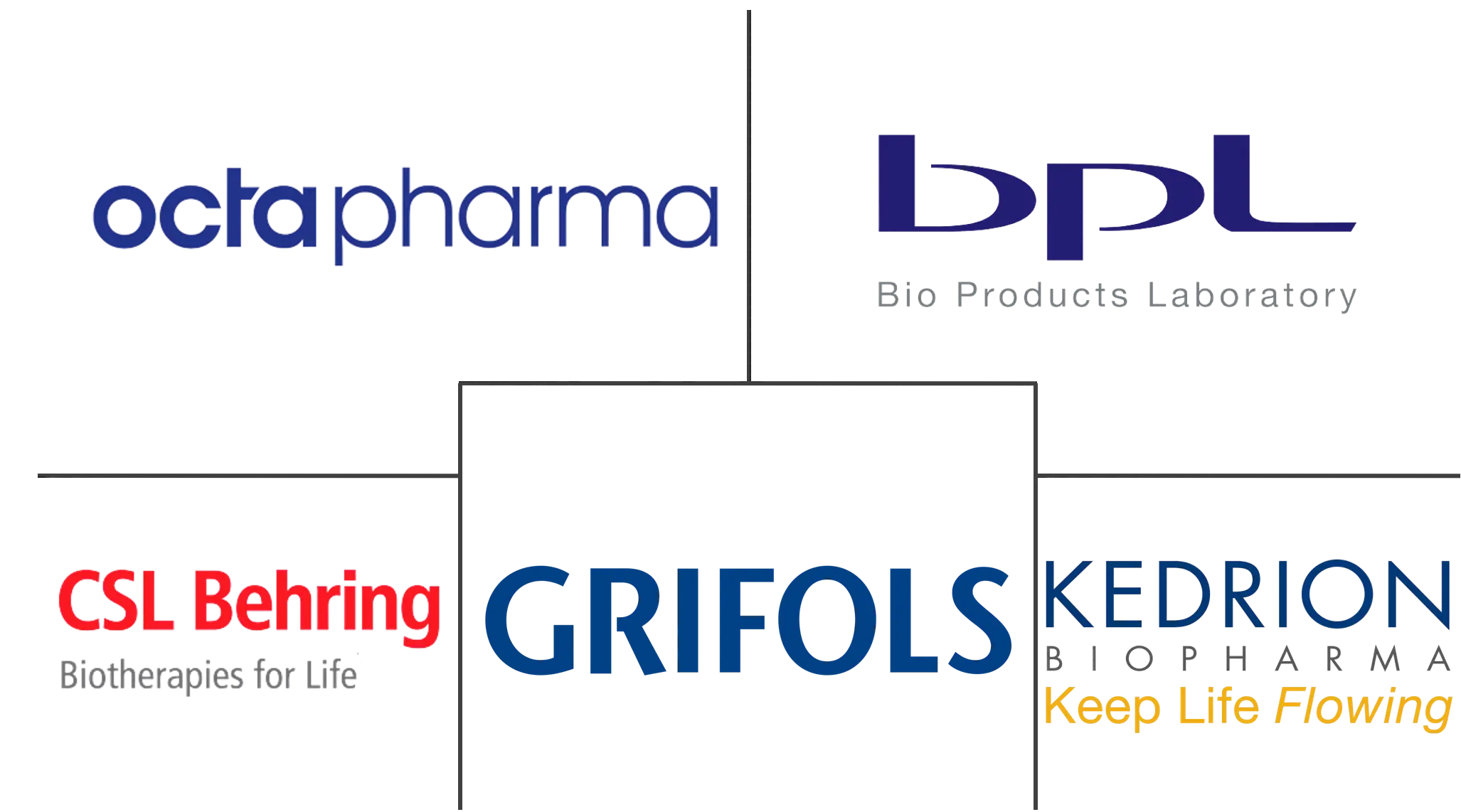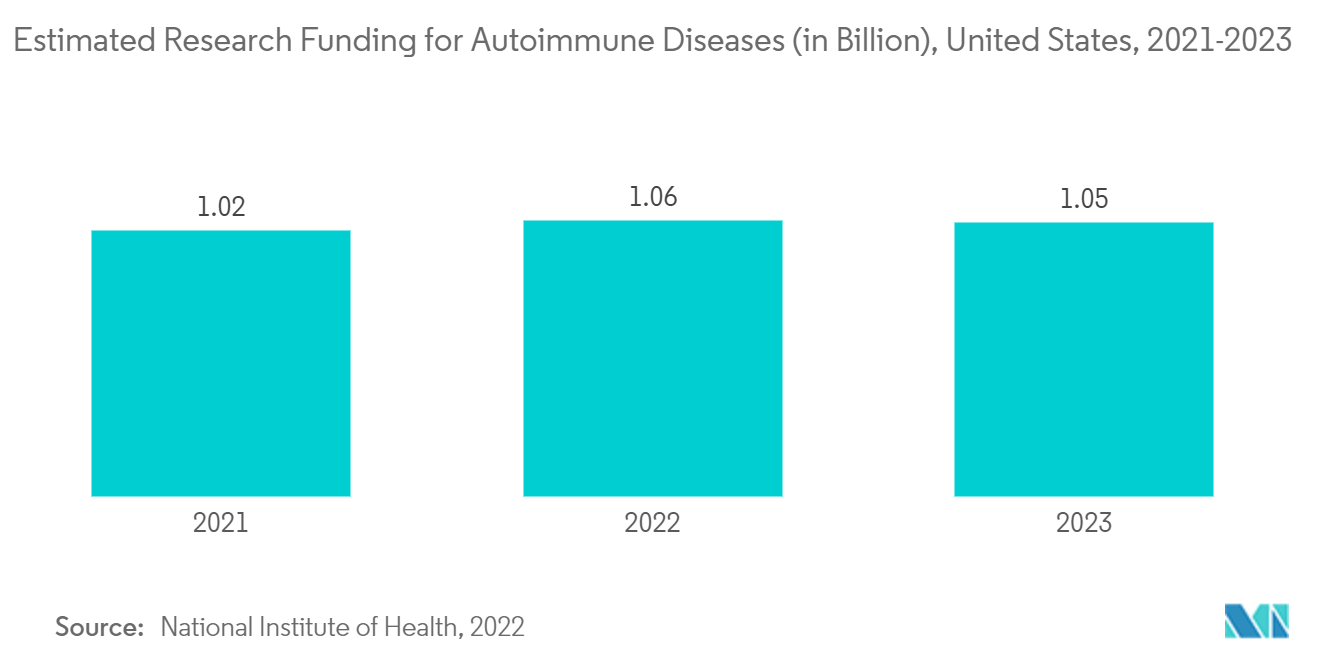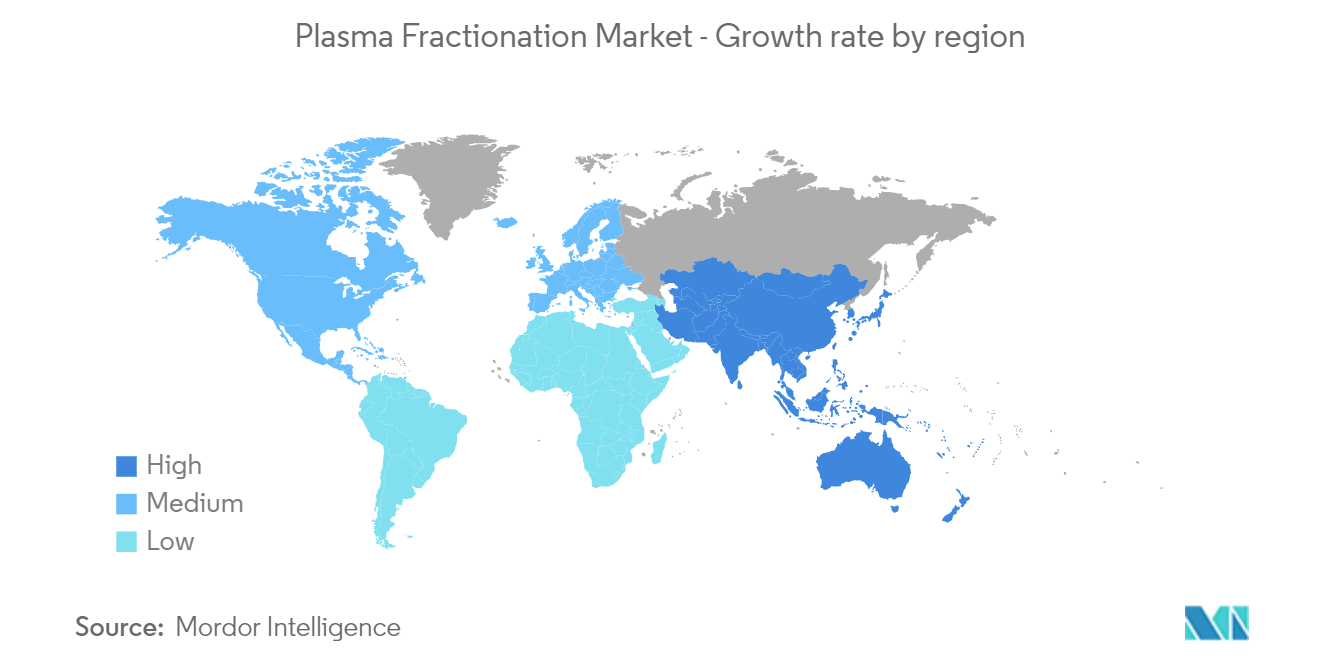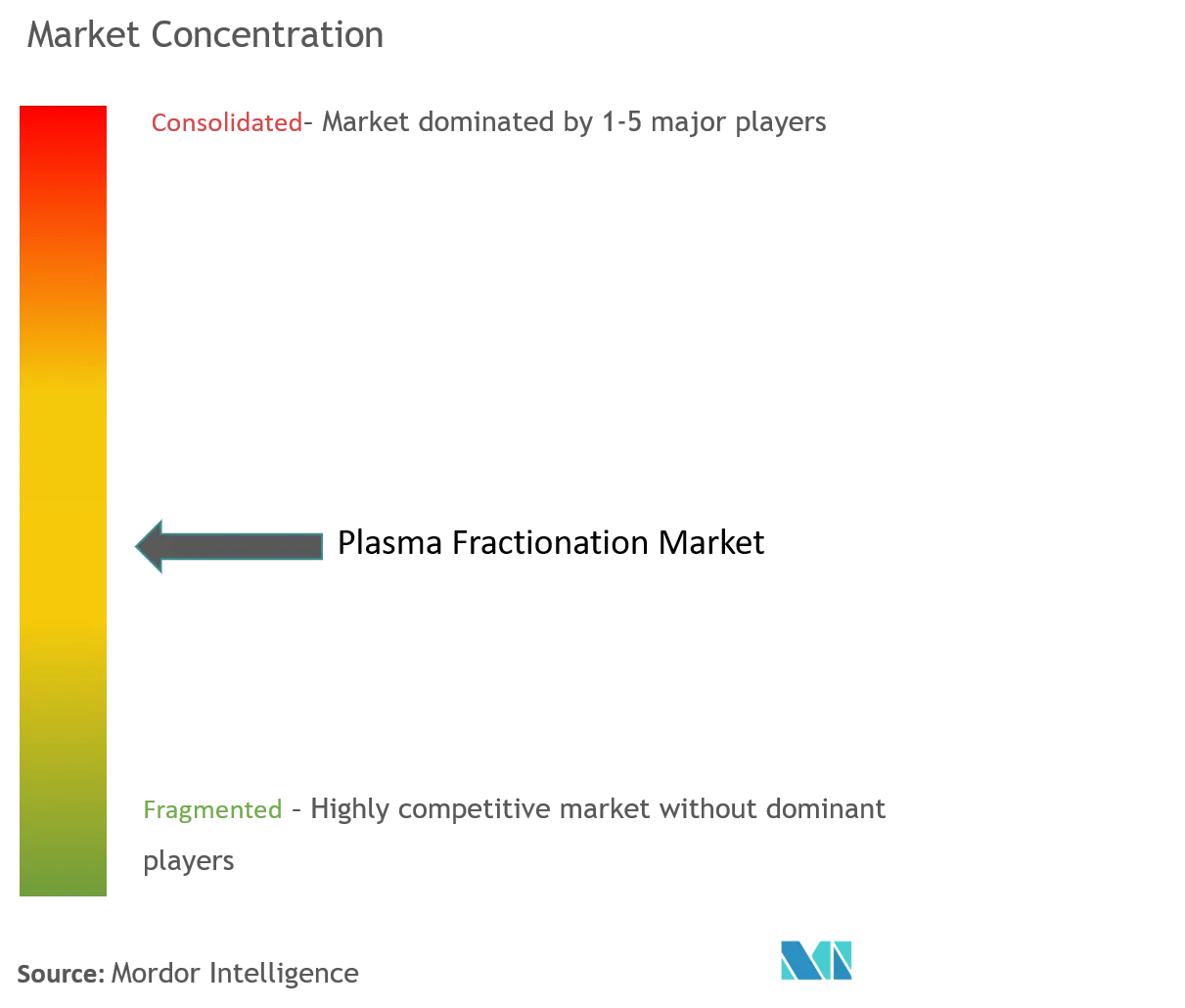Plasma Fractionation Market Size

| Study Period | 2019 - 2029 |
| Market Size (2024) | USD 34.90 Billion |
| Market Size (2029) | USD 48.55 Billion |
| CAGR (2024 - 2029) | 6.82 % |
| Fastest Growing Market | Asia Pacific |
| Largest Market | North America |
Major Players
*Disclaimer: Major Players sorted in no particular order |
Plasma Fractionation Market Analysis
The Plasma Fractionation Market size is estimated at USD 34.90 billion in 2024, and is expected to reach USD 48.55 billion by 2029, growing at a CAGR of 6.82% during the forecast period (2024-2029).
During COVID-19, the convalescent plasma demand increased, as the doctors initially treated the patients affected by the virus with convalescent plasma. For instance, according to an article published by frontiers in June 2021, convalescent plasma was widely used worldwide to treat patients hospitalized with coronavirus and prevent disease progression. Studies revealed that convalescent plasma transfusion contributes to improved symptomatology and viral clearance. Thus, there was an increasing need for plasma fractions to treat the COVID-19 patient initially. As the pandemic has subsided and fewer people are getting infected with the virus, the studied market is expected to have stable growth during the forecast period of the study.
Specific factors driving the market growth include the growing use of immunoglobulins in various therapeutic areas, the rising geriatric population coupled with rising in the prevalence of rare diseases, and the increasing number of plasma collection centers across the globe. For instance, according to the WHO facts of October 2022, the global population proportion aged 60 and up will nearly double by 2050. By 2050, 80% of the world's elderly will live in low- and middle-income countries and are also said to be aging much faster than in the past. Hence, with the rising geriatric population, the burden of rare diseases is also expected to increase worldwide, increasing the adoption of plasma fractionation products and thus driving the growth of the studied market. Furthermore, according to an article updated by NCBI in August 2022, Von Willebrand's disease is estimated to affect approximately 1% of the population globally. Still, clinically significant disease prevalence is estimated to be about 125 per million, with severe disease affecting up to five per million. Hence, the rising geriatric population coupled with the increasing burden of rare diseases like Von Willebrand is anticipated to drive the demand for plasma fractionation products, thereby boosting the market growth.
Moreover, the increasing number of plasma collection centers around the globe is also a significant factor in the growth of the studied market. For instance, in April 2022, Bio Products Laboratory Ltd (BPL), a leading manufacturer of plasma-derived protein therapies, opened its 29th plasma donation center. Furthermore, in October 2022, Freedom Plasma opened its fourth plasma donation center in Ohio, US. Hence, opening new plasma centers worldwide is expected to increase the production of plasma-based products, thus enhancing market growth.
Additionally, various activities by the key market players, such as product launches, partnerships, mergers, and acquisitions to bring technologically advanced plasma fractionation techniques and products into the market, are anticipated to boost the market. For instance, in January 2022, Octapharma received approval for expanding the indications of cutaquig in the European Union (EU). Cutaquig is a human immunoglobulin for subcutaneous administration. It provides flexible treatment options to many patients with acquired immune deficiencies.
Thus, factors such as the growing use of immunoglobulins in various therapeutic areas, the rising geriatric population coupled with rising in the prevalence of rare diseases, the increasing number of plasma collection centers, and various activities by the key market players are anticipated to boost the market over the forecast period. However, strict regulations for handling plasma protein products, high cost, and reimbursement issues restrain the market studied.
Plasma Fractionation Market Trends
Immunoglobulin Shows Lucrative Growth Opportunity in the Plasma Fractionation Market Over The Forecast Period
Immunoglobulin is being used in various disorders, including primary and secondary immune deficiencies, autoimmune diseases, and inflammatory diseases, which is driving the growth of this segment. According to the study published in the Therapeutics advances in Chronic Diseases in May 2022, intravenous immunoglobulin (IVIG) was reported to be one of the top three most used monotherapy in livedoid vasculopathy (LV). It is a safe and effective treatment for rare diseases.
Additionally, the growing prevalence of rare and autoimmune diseases and a surge in immunology research worldwide are factors driving the segment's growth. For instance, according to the data published by National Center for Advancing Translational Sciences in February 2022, it is estimated that about 7,000 to 10,000 rare diseases affect humans, out of which only a few hundred have any treatment. It also reported that each rare disease affects fewer than 200,000 individuals in the US. However, these illnesses affect an estimated 30 million people in total nationwide. Thus, the increasing number of rare diseases is driving the segment's growth.
According to a research study published by Springer in January 2022, Acquired hemophilia A (AHA) is a severe acquired rare bleeding disorder with which only 1-1.5 per million persons are affected yearly. AHA is characterized by suddenly appearing autoantibodies (inhibitors) that partially or wholly neutralize the activation or function or accelerate the clearance of factor VIII. People typically observe this disease in old age. Thus, increasing autoimmune disease prevalence is anticipated to increase the demand for immunoglobulin-based treatment, thereby growing the plasma fractionation market.
The market players are involved in developing innovative drugs and discovering new therapeutic areas for the existing drugs. For instance, in March 2022, Sanofi and IGM Biosciences, Inc. collaborated to create, develop, manufacture, and commercialize immunoglobulin antibody agonists against three oncology and immunology/inflammation targets. Thus, the rising research and development activity on immunoglobulins is boosting segment growth.
Thus, factors such as the growing prevalence of rare and autoimmune diseases and a surge in immunology research worldwide are anticipated to boost the segment over the forecast period.

North America is Expected to Hold a Significant Share in the Plasma Fractionation Market Over the Forecast Period
The North American region is expected to hold a significant share of the plasma fractionation market due to the presence of major players in the country, increasing research and development activities regarding plasma fractionation, rising geriatric population.
The rising prevalence of various genetic diseases, the growing geriatric population, and increasing healthcare expenditure are significant factors for the growth in the region. For instance, according to the March 2021 report of the Alzheimer's Association, approximately 6.2 million people of age 65 years and more are living with Alzheimer's-related dementia in the US. It is projected that this number will increase to 13.8 people by 2060. Thus, the high prevalence of Alzheimer's disease and the effectiveness of the plasma fractionation product in the treatment bolster the market growth over the forecast period.
Furthermore, according to the data from CDC in August 2022, the current male with hemophilia living in the US is estimated to be between 30,000 and 33,000. The estimated prevalence for hemophilia A in the US is 12 cases per 100,000 males and 3.7 cases per 100,000 US males for hemophilia B. The estimated incidence of hemophilia A among US births is one birth per 5,617 male births and one birth per 19,283 male births for hemophilia B. Thus, the high hemophilia incidence and higher plasma fractionation therapy adoption to treat hemophilia is expected to raise its demand over the forecast period, thereby boosting the market growth.
Additionally, the increasing plasma collection centers in the region, and growing developments for more plasma supply are also expected to enhance the market growth. For instance, in September 2022, Canadian Blood Services (CBS) partnered with Grifols SA to boost Canada's national blood plasma supply.
Moreover, rising initiatives from key market players are also expected to drive market growth in this region. For instance, in March 2021, BPL sold Grifols 25 plasma centers in the US, ensuring one million additional liters for plasma fractionation. Thus, such initiatives by the key market players are anticipated to drive the market's growth over the forecast period.
Therefore, owing to factors such as the rising prevalence of various genetic diseases, the growing geriatric population, increasing healthcare expenditure, and rising initiatives from key market players, the growth of the studied market is anticipated in the North American region.

Plasma Fractionation Industry Overview
The plasma fractionation market is moderately competitive and consists of several major players. Companies like Bio Products Laboratory, China Biologic Products, CSL Behring, Grifols S.A., Takeda Pharmaceutical Company Ltd, Kedrion S.p.A, Octapharma, Shanghai RAAS Blood Products, among others, hold a substantial market share in the market. These significant companies in the market are engaging in partnerships, mergers, and acquisitions, aiming to strengthen their product portfolios and manufacturing capacities and provide competitive differentiation.
Plasma Fractionation Market Leaders
-
CSL Behring
-
Grifols S.A
-
Octapharma
-
Kedrion S.p.A
-
Bio Products Laboratory
*Disclaimer: Major Players sorted in no particular order

Plasma Fractionation Market News
- October 2022- Grifols inaugurated a new albumin purification and filling plant at its global manufacturing and supply hub in Dublin, Ireland.
- September 2022- CSL Behring K.K. received manufacturing and marketing approval from the Ministry of Health, Labour and Welfare of Japan for Berinert S.C. Injection 2000, a lyophilized human C1-esterase inhibitor concentrate for subcutaneous (SC) injection in plasma derivative, for the prevention of acute hereditary angioedema (HAE) attack.
Plasma Fractionation Market Report - Table of Contents
1. INTRODUCTION
1.1 Study Assumptions and Market Definition
1.2 Scope of the Study
2. RESEARCH METHODOLOGY
3. EXECUTIVE SUMMARY
4. MARKET DYNAMICS
4.1 Market Overview
4.2 Market Drivers
4.2.1 Growing Use of Immunoglobulins in Various Therapeutic Areas
4.2.2 Rising Geriatric Population coupled with Rise in Prevalence of Rare Diseases
4.2.3 Increasing Number of Plasma Collection Centers across the Globe
4.3 Market Restraints
4.3.1 Strict Regulations For the Handling of Plasma Protein Products
4.3.2 Emergence of Recombinant Alternatives
4.3.3 High Cost and Limited Reimbursement
4.4 Porter's Five Forces Analysis
4.4.1 Bargaining Power of Suppliers
4.4.2 Bargaining Power of Buyers/Consumers
4.4.3 Threat of New Entrants
4.4.4 Threat of Substitute Products
4.4.5 Intensity of Competitive Rivalry
5. MARKET SEGMENTATION (Market Size by Value - USD million)
5.1 By Product
5.1.1 Immunoglobulins
5.1.2 Platelets and Coagulation Factor Concentrates
5.1.3 Albumin
5.1.4 Other Products
5.2 By Application
5.2.1 Neurology
5.2.2 Immunology
5.2.3 Hematology
5.2.4 Other Applications
5.3 By End-User
5.3.1 Hospitals and Clinics
5.3.2 Clinical Research Laboratories
5.3.3 Other End-Users
5.4 Geography
5.4.1 North America
5.4.1.1 United States
5.4.1.2 Canada
5.4.1.3 Mexico
5.4.2 Europe
5.4.2.1 Germany
5.4.2.2 United Kingdom
5.4.2.3 France
5.4.2.4 Italy
5.4.2.5 Spain
5.4.2.6 Rest of Europe
5.4.3 Asia-Pacific
5.4.3.1 China
5.4.3.2 Japan
5.4.3.3 India
5.4.3.4 Australia
5.4.3.5 South Korea
5.4.3.6 Rest of Asia-Pacific
5.4.4 Middle East and Africa
5.4.4.1 GCC
5.4.4.2 South Africa
5.4.4.3 Rest of Middle East and Africa
5.4.5 South America
5.4.5.1 Brazil
5.4.5.2 Argentina
5.4.5.3 Rest of South America
6. COMPETITIVE LANDSCAPE
6.1 Company Profiles
6.1.1 Bio Products Laboratory
6.1.2 CBPO Group (China Biologic Products)
6.1.3 CSL Behring
6.1.4 Grifols S.A.
6.1.5 Takeda Pharmaceutical Company Ltd
6.1.6 Kedrion S.p.A
6.1.7 Octapharma
6.1.8 Shanghai RAAS Blood Products
6.1.9 Sanquin
6.1.10 LFB corporation
6.1.11 GC Pharma
6.1.12 PlasmaGen BioSciences Pvt. Ltd.
- *List Not Exhaustive
7. MARKET OPPORTUNITIES AND FUTURE TRENDS
Plasma Fractionation Industry Segmentation
As per the scope of the report, plasma fractionation is defined as the general process of separating the various components of blood plasma obtained via blood fractionation. Plasma contains multiple proteins, including immunoglobulins, albumin, and coagulation proteins. The Plasma Fractionation Market is segmented by product (immunoglobulins, platelets, coagulation factor concentrate, albumin, and other products), application (Neurology, Immunology, Hematology, and other applications), end-user (hospitals and clinics, clinical research laboratories, and other end-users), and geography (North America, Europe, Asia-Pacific, Middle East and Africa, and South America). The market report also covers the estimated market sizes and trends for 17 countries across major global regions. The report offers the value in (USD million) for the above segments.
| By Product | |
| Immunoglobulins | |
| Platelets and Coagulation Factor Concentrates | |
| Albumin | |
| Other Products |
| By Application | |
| Neurology | |
| Immunology | |
| Hematology | |
| Other Applications |
| By End-User | |
| Hospitals and Clinics | |
| Clinical Research Laboratories | |
| Other End-Users |
| Geography | ||||||||
| ||||||||
| ||||||||
| ||||||||
| ||||||||
|
Plasma Fractionation Market Research FAQs
How big is the Plasma Fractionation Market?
The Plasma Fractionation Market size is expected to reach USD 34.90 billion in 2024 and grow at a CAGR of 6.82% to reach USD 48.55 billion by 2029.
What is the current Plasma Fractionation Market size?
In 2024, the Plasma Fractionation Market size is expected to reach USD 34.90 billion.
Who are the key players in Plasma Fractionation Market?
CSL Behring, Grifols S.A, Octapharma, Kedrion S.p.A and Bio Products Laboratory are the major companies operating in the Plasma Fractionation Market.
Which is the fastest growing region in Plasma Fractionation Market?
Asia Pacific is estimated to grow at the highest CAGR over the forecast period (2024-2029).
Which region has the biggest share in Plasma Fractionation Market?
In 2024, the North America accounts for the largest market share in Plasma Fractionation Market.
What years does this Plasma Fractionation Market cover, and what was the market size in 2023?
In 2023, the Plasma Fractionation Market size was estimated at USD 32.52 billion. The report covers the Plasma Fractionation Market historical market size for years: 2019, 2020, 2021, 2022 and 2023. The report also forecasts the Plasma Fractionation Market size for years: 2024, 2025, 2026, 2027, 2028 and 2029.
What are the factors driving the growth of the Plasma Fractionation Market?
The factors driving the growth of the Plasma Fractionation Market are a) Rising demand for immune globulins b) Aging population c) Increasing awareness of plasma-derived therapies
What are the factors driving the growth of the Plasma Fractionation Market?
The factors driving the growth of the Plasma Fractionation Market are a) Rising demand for immune globulins b) Aging population c) Increasing awareness of plasma-derived therapies
Plasma Fractionation Industry Report
The global plasma fractionation market is experiencing significant market growth, driven by the increasing demand for immunoglobulins and plasma-derived products used in treating various diseases such as respiratory conditions and Alpha-1 Antitrypsin Deficiency (AATD). This market growth is further supported by advancements in diagnostics, expansion of plasma collection centers, and strategic inventory management by key players. Despite facing challenges such as high costs and potential disruptions from recombinant alternatives, the industry sees opportunities in regions aiming for plasma fractionation self-sufficiency and policy revisions to boost domestic plasma product supply.
The industry analysis highlights the market segmentation by product, application, end-user, and geography, offering a comprehensive industry overview. The market size is segmented by immunoglobulins, platelets, coagulation factor concentrate, albumin, and other products. Applications span across neurology, immunology, hematology, and other fields, with end-users including hospitals and clinics, clinical research laboratories, and other entities. The industry reports provide detailed market data, market predictions, and market review, ensuring a thorough understanding of the industry's dynamics.
In terms of market forecast, the industry is poised for continued expansion, particularly focusing on immunoglobulins and coagulation factors. The market outlook is positive, with new market segments in neurology and beyond being tapped into. The industry research emphasizes the importance of strict regulations to ensure product safety and quality, which is crucial for maintaining market value and industry statistics.
The market leaders are adapting to these changes, and the market trends indicate a growing emphasis on regional self-sufficiency in plasma fractionation. The report example and report pdf from Mordor Intelligence™ Industry Reports offer a detailed analysis and free download for further insights. This industry information is vital for understanding the market segmentation and market value, providing a clear industry outlook and market overview.
Overall, the plasma fractionation market is set for significant growth, with a strong focus on industry sales and market segmentation. The market data and industry trends provide a comprehensive view of the market's potential, ensuring stakeholders are well-informed about the industry's direction and opportunities.



